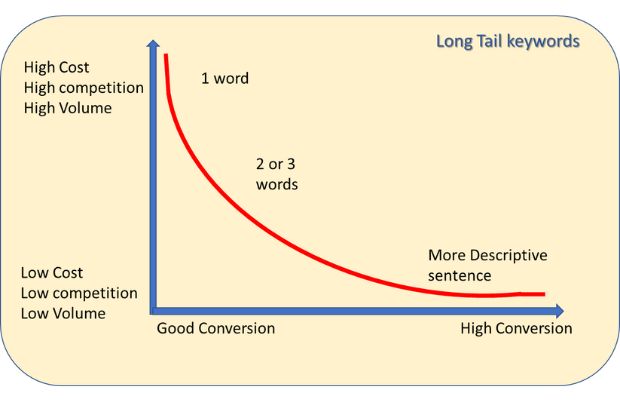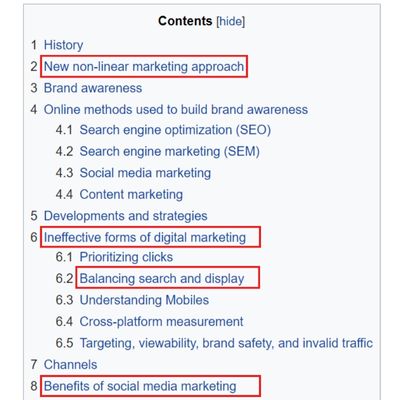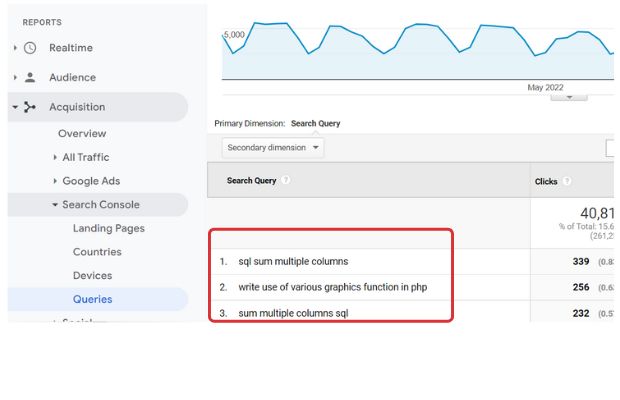Long Tail Keywords

When we search for highly competitive single word queries like online shopping, Freelancer or Digital Marketing, we will find established sites at the first page of search result. Can your site rank in the same place for these types of queries by competing with the already existing and highly authoritative sites?
You can plan and develop the content targeting these types of competitive seed or primary keywords. But, getting a good rank for these keywords is extremely difficult. These types of single word search terms bring a lot of traffic as the search volume is very high. Sites which get high ranking in search result pages for such short keywords and competitive words are highly authoritative sites and they are the leaders in their respective areas.
Generating Long tail keywords as for part of SEO and content strategy for higher conversion traffic
For a new web site or a site which is less authoritative, it is very difficult to be in the first page of search results, especially for these types of competitive queries.
Even for established sites, to build a new content pivot (new areas), the starting point should be to prepare the content around the long tail keywords of the targeted niche.
What are the Long tail keywords ?

The queries with more 'Specific search intention' and having more than two or three key word phrases are termed as Long tail keywords.
Though less in search volume, these long tail keywords offer high conversion and good ranking because of less competition.
Examples of Long tail keywords
For our easy understanding let us divide our collection of queries in three parts.Primary Keyword or seed keyword
Short tail Keywords
Long tail keywords.
Our task is to prepare a content strategy focusing on queries having the word Marketing (highly difficult to rank) and prepare some short tail keywords Digital Marketing (difficult) and long tail keywords (less difficult).
Here are queries with the classifications.
Marketing
Digital Marketing
Digital Marketing
Social media Marketing
Digital Marketing SEO
Digital Marketing SEO
digital marketing salary entry level
digital marketing training institute in NewDelhi
digital and social media marketing
digital marketing agency in peterborough
digital marketing course online free
digital marketing for financial services
digital marketing for food products
what is lead generation in digital marketing
how to create a digital marketing strategy
difference between digital marketing and web development
digital marketing training institute in NewDelhi
digital and social media marketing
digital marketing agency in peterborough
digital marketing course online free
digital marketing for financial services
digital marketing for food products
what is lead generation in digital marketing
how to create a digital marketing strategy
difference between digital marketing and web development
From the above classification, you may be able to add your own list of queries with Long tail keywords. Here, as we move towards more words in the query, the search volume decreases. So, while preparing a list, we have to keep measuring the search volume. There is no point in adding more words (or tail to the primary key word) where there are few or no search queries. We need to balance between 'Required effort to create the content' and 'Return in terms of search volume'.
Why should we focus on Long trail keywords?
You must be aware of this famous quote;A journey of a thousand miles begins with a single step
In Search Engine Optimization (SEO), a journey towards single word ranking starts with long tail keywords.
Advantages of targeting Long tail Keywords.
As the search query for the niche area remains highly focused, the conversion increases. Think of a user who wants to hire a digital marketing agency for social media promotion for his new restaurant near the bus stop.As you are targeting one specific area and local business, the cost per click or the cost of promotion of your product or services will be less compared to a wide area or generic terms with high competition. Due to narrow area and easy availability of data, high level of analysis can be performed for better ad placement and to get better return.
Conversion rate will be high as you are nearly matching or exactly matching to the search intent of the customer.
A digital marketing agency will try to optimize the promotional content and ad placement strategy focusing highly on the targeted market by the help of the Long tail Keywords.
Disadvantages
As the keyword combinations increase, the search volume decreases. Due to less traffic, the effort required here is more with little or no success. Though the conversion is high here, due to less traffic the required level of targeted turnover will take more time. As the effort required to build the content around Long tail keywords are more, check this statement taken from a discussion.In one reply, Google’s John Mueller responded that "it’s really hard to call a site authoritative after 30 articles."
We may have to work on more areas or prepare more content to establish in the market using the long tail keywords.
Dragon's tail goes on and on
 15% of all search queries submitted to Google are new queries which Google has not encountered before. It tells that the user search queries are not constant and it changes over time and new requirements come up. So there is no shortage of long tail keywords and the opportunities are always there for new or established sites to try these new requirements. News, events, new tourist attractions, seasonal queries, political developments, trending topics are some examples where search queries keep on changing by creating new types of long tail keywords.
15% of all search queries submitted to Google are new queries which Google has not encountered before. It tells that the user search queries are not constant and it changes over time and new requirements come up. So there is no shortage of long tail keywords and the opportunities are always there for new or established sites to try these new requirements. News, events, new tourist attractions, seasonal queries, political developments, trending topics are some examples where search queries keep on changing by creating new types of long tail keywords.
Dragon bites its own tail
It is always preferred to focus on Long tail keywords of your niche areas or in the keywords where you have established your Authoritativeness ( This is part of the word E-A-T here ). The continuum of the niche is key to establish here and building content around Long tail keywords should be the focus for the content strategy.Note : It will take time and effort if you shift your content pivot. Try to remain focused in your area if your site is new.
Where is the tail ( how to find long tail keywords? )
The key question remains how to identify these Long tail keywords? From a broad term we need to find out the keywords matching to the specific niche of the business strategy. Here are some tools to guide.Google Suggest
While searching for a primary keyword in google, check for the suggestions shown by google. These are based on queries on previous searches stored in google database. These are subqueries or areas that can be targeted to plan for preparing the content.People also ask
Google, while returning the result from a query, it shows a list of related questions the searchers usually ask. This is also based on historic data stored in google database. Try to include the answers of these questions while developing the content. Usually these questions include the long tail keywords with diverse search intentions.Related search
Scroll down to the end of the google search result page , you will get a list or related searches. Google algorithm understands the related areas of search term and shows a list of related searches.Try to Search Digital Marketing You will find a related search list like What is digital marketing explain with examples pdf.
Keyword analysis , planner
One popular free tool is google keyword planner, which returns related keywords with search volume and ranking difficulties. Using the primary keywords try to search and you can download the list of related keywords with search volume and ranking difficulty.There are some paid tools and almost all have free versions with limited access. You can start with tools provided by semrush.com, ahrefs.com, screamingfrog.co.uk,neilpatel.com
Google trends

This wonderful tool gives you ideas about search trends over time and geographical areas. Up to five different keywords can be compared over time and countries to target. It gives a list of related topics and related queries over the word which is being searched.
You can use google api to get your data automatically and create your own analysis using the same.
Here are few lines of Python program to get your data from google trends. Use the free Google Cloud Platform ( Colab ) to build a list for further analysis.
Pytrends to get data from Google Trends
Pytrends to get data from Google Trends
Wikipedia table of content
 Wikipedia is a reliable source of content and you can visit the page by searching relevant keyword and take a look into the table of content section.
Wikipedia is a reliable source of content and you can visit the page by searching relevant keyword and take a look into the table of content section.Many related long tail keywords you will find here. They may give you some more ideas on how to target a focused area of your niche.
It is not necessary that all those words are to be targeted, these words can be used to generated ideas on the sub topics or small but targeted areas to focus on the subject.
Question Hub by Google
Here, you will get unanswered questions ( known as content gap ) on your topic. By addressing these content gaps, creators can create rich content and rank well in less competitive areas. Usually you will get long sentences matching to your niche and this is an excellent source for long tail keywords.Using this platform you can build the content. You can submit your page URL matching the available questions. If your page doesn’t have the exact matching answer, then add the content by answering the question and then submit the URL in the question hub.
Inside the question hub you can follow any topic.
Your analytics or Search console

Take a look at your analytics tools for keywords. Inside google analytics, visit Acquisition > Search Console > Queries . You can download a list of queries for which you already have ranking. This list can be used to further improve or target related areas for building content. Note that outside this list there are queries in your targeted topics for which you are not having ranking. You may have to do a competitor analysis to target these keywords
Q&A sites like Quora, answers
 Observe these sites for matching questions and answers related to the targeted topics. It provides inputs to develop content around your areas.
Wikipedia table of content
For a site, focusing on informative content, Wikipedia gives good answers to almost all types of content. The sub - topics are listed in a table which can be used for developing topics around long tail keywords.
Observe these sites for matching questions and answers related to the targeted topics. It provides inputs to develop content around your areas.
Wikipedia table of content
For a site, focusing on informative content, Wikipedia gives good answers to almost all types of content. The sub - topics are listed in a table which can be used for developing topics around long tail keywords.
long tail keywords vs short tail
Start building content around long tail keywords. This may go into your title of the page or you can build anchor text pointing to the targeted page. Once you have sufficient numbers of content around long tail topics of your niche, then try to pivot the contents by funneling the same towards a short tail. Your short tail contents are focused towards queries having two or three words. Such short words or phrases are highly competitive and it is expected that required entity information with strong brand building will push the content towards a better ranking with these short keywords.Is your short tail ready ? It is time to go for the primary keyword.
Conclusion
Higher ranking for competitive primary keywords is not so easy. As you move towards your primary keyword, the journey must be through establishing you as an author or the site as the key entity to establish E-A-T over the competition. Starting with Long tail keywords should be the building blocks for a planned journey for Number one position. Posting a high number of blog posts may help but may not be sufficient to sustain the number 1 or 2 position for a primary keyword. The entity information around the topic must support the web site or the author to remain visible and to maintain the position for a long time. As their are new search queries is being used, Continuous monitoring of Long Tail Keywords and planning the content
This article is written by plus2net.com team.
Be the first to post comment on this article :

Search Engine Optimization and google articles
 Google Analytics 4
Google Analytics 4 SEO glossary
SEO glossary Webmaster tools to Diagnose problems and crawl issues
Webmaster tools to Diagnose problems and crawl issues  HTTP error code and messages
HTTP error code and messages  Search engine friendly page design
Search engine friendly page design  Quality Site for higher ranking in Search engines
Quality Site for higher ranking in Search engines  Checklist for a new website for future ranking
Checklist for a new website for future ranking  Fast loading Page
Fast loading Page  Black Hat Search Engine Optimization - SEO
Black Hat Search Engine Optimization - SEO  rel=nofollow: Preventing comment spam
rel=nofollow: Preventing comment spam  google alert
google alert  robots.txt file of a site
robots.txt file of a site  google trends for comparing & monitoring traffic
google trends for comparing & monitoring traffic  Searching google within a site for number of pages
Searching google within a site for number of pages  Monitoring Rank
Monitoring Rank  Long tail Keywords
Long tail Keywords